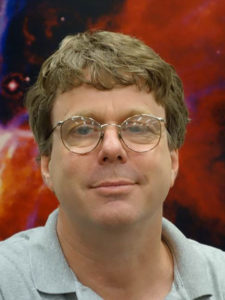Finding new planets that could support life
Finding new planets that could support life
Searching for Habitable Worlds
Finding new planets that could support life
Life outside of our solar system
MIT scientists are continuing to use new methods and instrumentation to seek out new worlds that could show we are not alone in the universe.
TESS, The Transiting Exoplanet Survey Satellite, is an MIT-led NASA mission discovering exoplanets, worlds beyond our solar system. TESS monitors millions of stars for temporary drops in brightness caused by planets passing in front of their host stars. This first-ever spaceborne all-sky transit survey has identified planets of all sizes, thousands of them. TESS also finds and monitors all types of objects that change in brightness, from nearby asteroids to pulsating stars and distant galaxies containing supernovae.
In addition to exoplanet research, scientists at the MIT Kavli Institute for Astrophysics and Space Research are making detailed studies of planetary compositions and atmospheres with observations from telescopes including Magellan and JWST, and theoretical studies to understand the properties of planetary atmospheres and how gravitational interactions can sculpt populations.
Highlights
Water is life?
Planets without water could still produce certain liquids
Water is life?
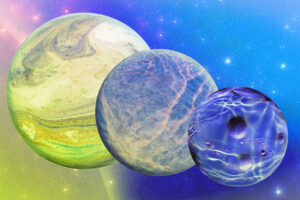
Sara Seager, the Class of 1941 Professor of Planetary Sciences in the Department of Earth, Atmospheric and Planetary Sciences, and other researchers propose that, even on planets that are too warm or that have atmospheres are too low-pressure to support liquid water, there could still be pockets of ionic liquid. And where there is liquid, there may be potential for life, though likely not anything that resembles Earth’s water-based beings.
Crumbling Planet
Astronomers discover a planet that’s rapidly disintegrating, producing a comet-like tail
Crumbling Planet
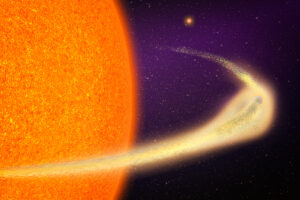
MIT astronomers have discovered a planet some 140 light-years from Earth that is rapidly crumbling to pieces. The disintegrating world is about the mass of Mercury, although it circles about 20 times closer to its star than Mercury does to the sun, completing an orbit every 30.5 hours. At such close proximity to its star, the planet is likely covered in magma that is boiling off into space. As the roasting planet whizzes around its star, it is shedding an enormous amount of surface minerals and effectively evaporating away. Using the NASA’s Transiting Exoplanet Survey Satellite (TESS), it appears that the planet is disintegrating at a dramatic rate, shedding an amount of material equivalent to one Mount Everest each time it orbits its star. At this pace, given its small mass, the researchers predict that the planet may completely disintegrate in about 1 million to 2 million years.
Dive into TESS's Southern Sky Panorama
Dive into TESS's Southern Sky Panorama
NASA’s Transiting Exoplanet Survey Satellite (TESS) spent a year imaging the southern sky in its search for worlds beyond our solar system. Dive into a mosaic of these images to see what TESS has found so far. Music: “Phenomenon" from Above and Below Written and produced by Lars Leonhard Credit: NASA/MIT/TESS
Your browser does not support video embeds, please follow the link below to watch the video.
https://www.youtube.com/embed/P3KevBr4go4?feature=oembed&controls=1&hd=1&autohide=1&showinfo=0&modestbranding=1&rel=0&color=whiteTESS discovers "Super-Earth" and two "Sub-Neptune" planets
Planet-hunting satellite TESS finds 'missing link' exoplanets
TESS discovers "Super-Earth" and two "Sub-Neptune" planets
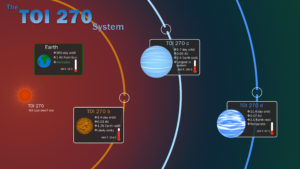
"TOI-270 is a true Disneyland for exoplanet science, and one of the prime systems TESS was set out to discover," MIT Kavli Institute for Astrophysics and Space Research postdoctoral scholar Maximilian Günther said. "It is an exceptional laboratory for not one, but many reasons -- it really ticks all the boxes."
Earth-sized planet discovered
First Earth-sized planet discovered by TESS
Earth-sized planet discovered
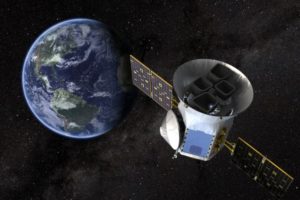
NASA’s Transiting Exoplanet Survey Satellite, TESS, has discovered its first Earth-sized exoplanet. The planet, named HD 21749c, is the smallest world outside our solar system that TESS has identified yet. ... “For stars that are very close by and very bright, we expected to find up to a couple dozen Earth-sized planets,” says lead author and TESS member Diana Dragomir, a postdoc in MIT’s Kavli Institute for Astrophysics and Space Research. “And here we are — this would be our first one, and it’s a milestone for TESS. It sets the path for finding smaller planets around even smaller stars, and those planets may potentially be habitable.”
NASA's TESS rounds up its first planets, snares far-flung supernovae
NASA's TESS rounds up its first planets, snares far-flung supernovae
TESS has found three confirmed exoplanets in the data from the space telescope’s four cameras.
Your browser does not support video embeds, please follow the link below to watch the video.
https://www.youtube.com/embed/JFdpMes9C-c?feature=oembed&controls=1&hd=1&autohide=1&showinfo=0&modestbranding=1&rel=0&color=whiteSeven Earth-sized planets
Discovering ‘habitable-zone’ planets
Seven Earth-sized planets
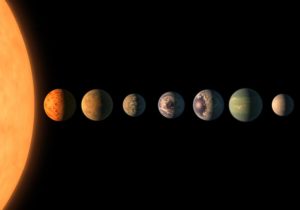
Scientists used observations from NASA's Spitzer Space Telescope and the ground-based TRAPPIST (TRAnsiting Planets and PlanetesImals Small Telescope) telescope, as well as other ground-based observatories, to identify seven planets orbiting an ultra-cool dwarf star. All seven planets are Earth-sized and terrestrial — and all could potentially harbor liquid water.
The Team
News
-
Study finds exoplanet TRAPPIST-1e is unlikely to have a Venus- or Mars-like atmosphere
September 8, 2025
-
Astronomers discover a planet that’s rapidly disintegrating, producing a comet-like tail
April 22, 2025
-
Astronomers spot a highly “eccentric” planet on its way to becoming a hot Jupiter
July 17, 2024
-
Astronomers discover six planets orbiting a nearby sun-like star
November 29, 2023
-
Bright flash leads astronomers to a heavy-metal factory 900 million light years away
October 25, 2023
-
This star ate its own planet. Earth may share the same fate
May 3, 2023
-
Green comets, new planets, and images that have astronomers rethinking the Big Bang
January 19, 2023
-
One year on this giant, blistering hot planet is just 16 hours long
November 23, 2021
-
Astronomers discover an Earth-sized “pi planet” with a 3.14-day orbit
September 21, 2020
-
How do scientists discover planets light years away? There's an art to it, MIT researchers say
September 17, 2019
-
Billions of exoplanets? Count on it, say space scientists
December 31, 2017
Please contact Jennifer Rosales if you are considering a gift to the School of Science.




